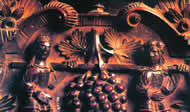 |
|
|
  Wood carving in Macedonia in the 13th century continued its development with new vigour and was enriched by new elements. The members of the Mijak wood-carver's school introduced the human figure in their artistic works and integrated it within the ornamental whole in an amazing way. The art of wood carving was not confined to churches and monasteries only: wood-carvers' tajfi (groups) began to decorate mosques, as well as sarajs (mansions) and houses of wealthy merchants. In 1814, Petre Filipovski's "tajfas" from the village of Gari made the Great Iconostasis, kept in the National Library in Belgrade until World War II when it was destroyed by bombing. Petre Filipovski "Garka," his brother Marko, and Makarie Frckovski from Galicnik worked on the iconostasis in the Church of the Holy Saviour in Skopje from 1824 to 1829 — an iconostasis ten metres long and six metres high. Some of the characters in the Biblical scenes are depicted dressed in Galicnik folk costumes. Art historians are unanimous that the value of this masterpiece lies in the softness of its lines, its arrangement of the forms, its stylisation and its baroque playfulness. In the period from 1830 to 1840, the famous master wood-carvers Petre Filipovski and Makarie Frckovski carved the iconostasis in the Monastery of St. John of Bigor. They left behind self-portraits among the scenes of this iconostasis and again on the iconostasis in the Church of the Holy Savior. The iconostasis in St. John the Baptist is a grandiose example of Macedonian wood carving, divided into six horizontal squares abounding in floral and animal ornaments. Wood carving in Macedonia in the 13th century continued its development with new vigour and was enriched by new elements. The members of the Mijak wood-carver's school introduced the human figure in their artistic works and integrated it within the ornamental whole in an amazing way. The art of wood carving was not confined to churches and monasteries only: wood-carvers' tajfi (groups) began to decorate mosques, as well as sarajs (mansions) and houses of wealthy merchants. In 1814, Petre Filipovski's "tajfas" from the village of Gari made the Great Iconostasis, kept in the National Library in Belgrade until World War II when it was destroyed by bombing. Petre Filipovski "Garka," his brother Marko, and Makarie Frckovski from Galicnik worked on the iconostasis in the Church of the Holy Saviour in Skopje from 1824 to 1829 — an iconostasis ten metres long and six metres high. Some of the characters in the Biblical scenes are depicted dressed in Galicnik folk costumes. Art historians are unanimous that the value of this masterpiece lies in the softness of its lines, its arrangement of the forms, its stylisation and its baroque playfulness. In the period from 1830 to 1840, the famous master wood-carvers Petre Filipovski and Makarie Frckovski carved the iconostasis in the Monastery of St. John of Bigor. They left behind self-portraits among the scenes of this iconostasis and again on the iconostasis in the Church of the Holy Savior. The iconostasis in St. John the Baptist is a grandiose example of Macedonian wood carving, divided into six horizontal squares abounding in floral and animal ornaments.
From Macedonia Yesterday and Today by Jovan Pavlovski & Misel Pavlovski (www.mian.com.mk)
Translated by: Zaharija Pavlovska
|
back |
|
|
|
|
|
|